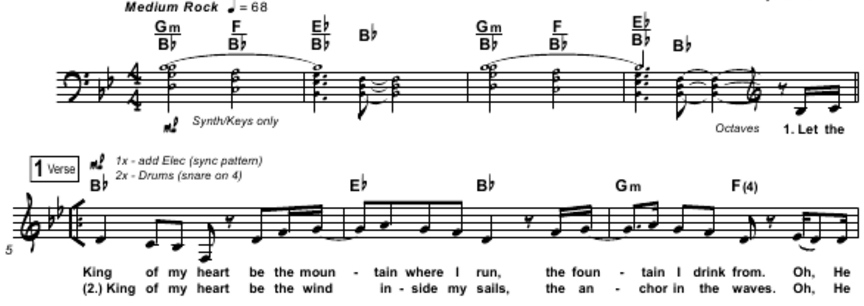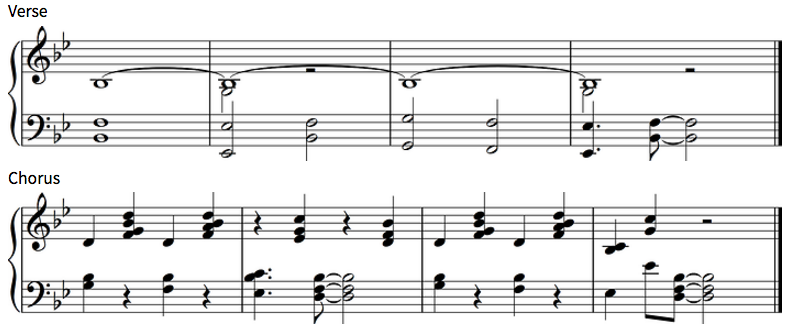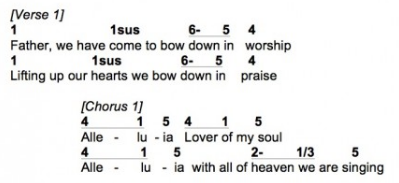
Sheet Music Overview and Purpose
Chord charts, lead sheets, Nashville number charts and more.
Your Guide to Sheet Music
Let’s talk about sheet music! When leading any kind of band, including a worship band, knowing how to navigate the technical side of sheet music is a must. We understand, however, how overwhelming sheet music can seem when you’re somewhat unfamiliar. With so many different kinds, it can be hard to know where to start. We use the term ‘sheet music’ because all types of printed music can fall into this category. Every situation and context will call for different things, and all musicians will have their own preferences.
In this article, we aim to break down everything you need to know about sheet music, from overviews and purposes to how to use printed music in worship contexts. Our goal is to take your music skills beyond simply leading hymns during the Christmas service. Let’s dive right in, and learn how to find joy in using sheet music – rather than finding it overwhelming!
This article outlines some of the basics of printed music. To find Christian sheet music, check out Worship Artistry today.
Chord Charts, Lead Sheets, Nashville Number Charts, And More!
Why bother with sheet music? For many worship leaders and Christian musicians, the focus can be on memorizing classic worship songs and knowing those go-to Christian pieces. Taking the time to learn the world of sheet music, from chord charts to lead sheets, can help you to sharpen your skills and elevate your worship leading skills. As a Christian, learning to use your talents to praise God and help others to do the same is a great privilege. What a joy!
So, let’s get your technical skills in the best position possible and turn you into the best worship band leader you can be! And that all starts with understanding the basics of sheet music.
Chord Charts
Chord charts are probably the most common chart that churches use today. It contains the song lyrics with the chord symbols written above. It does not contain any music notation, rhythms, staves, etc. The sole purpose of this chart is to remind you of the chords to play. Because it's only chords and lyrics, it doesn't tell you specifically when to play the chords. You can guess your way through it by watching the lyrics, but it doesn't give you specifics.
The prerequisite for using this kind of chart is that you are already somewhat familiar with the song. If there are syncopated rhythms, rests, holds, etc, you have to already know those by way of listening to the song itself because the chord chart isn't going to tell you any of that. However, if you've listened to the song and are familiar with it, the chord chart is a great (usually one-page) solution for musicians, especially those who play by ear.
If you have musicians who need to read notes, then this is not the chart for them.

Lead Sheets
Lead sheets are the perfect all-around chart. They include one staff with chords, lyrics, melodies, and rhythms, so musicians and singers alike can use them. If you have never played a song before— or even heard it for that matter— you can manage about 90% of it with the lead sheet. A downside is that they are almost always more than just one page (usually 2-3+ pages), but they are better than a full piano/vocal chart that potentially could be 10+ pages.
A lead sheet can provide the melody along with the harmonies for the singers. They always include the lyrics, and they're great for musicians because they show specific rhythms, chords, and melodies. If there's a guitar lead line, it's probably written out. If there are specific holds and stops, those are written as well. This is what makes the lead sheet a great all-around chart to use for your team. I almost always use this for my teams when learning a new song. Once they have it, I'll switch over to chord charts so they have a reminder.

Rhythm Charts
Rhythm charts are used in settings where a rhythm section (keys, bass, drums, guitars) is accompanying a choir and/or orchestra. They are almost identical to the lead sheet except they don't contain lyrics, melodies, and harmonies. A single staff will have slash bars to indicate beats while chords will be written above the staff just like the lead sheet. If there are specific rhythms or melodies to be played, those will be notated. Usually, the rhythm chart is about the same length as the lead sheet, so it's just as effective to use the lead sheet since seeing the lyrics can help keep you on track if you get lost for some reason.

Piano and Vocal Score
Piano/vocal scores are typically used in choral settings as well as by pianists who have to read notes. It can contain four staves (two with vocal parts and a grand staff for the piano). It's the most comprehensive chart out of those mentioned. It contains all the same elements as the lead sheet with the added bass clef for the pianist to read. These charts can be quite long depending on the song, which means there are a lot of page turns!
The only time I've really used this chart is in choral settings vocal rehearsals where there are more than three parts, and times where I'm required to play exactly what's in the sheet music. Other than that, I'll take the lead sheet any day!

Nashville Numbers Chart
A Nashville number chart can be part of any of the first three charts, but instead of seeing chords with letters it uses, well, numbers. Every chord in a specific key has a specific number attached to it. For example, in the key of C C, Dm, Em, F, G, Am, Bdim would be 1, 2m, 3m, 4, 5, 6m, 7dim.
It's called the Nashville number system because Nashville studio musicians would often have to record songs in different keys. Rather than having multiple charts in different keys, they could have just one chart with numbers and transpose on the fly. The ability to think in terms of numbers is one of the greatest techniques any musician can develop. If I do use a chord chart, I almost always use a numbers chart because it allows the flexibility of changing keys without changing charts.

Finding the Best Chart for Your Band
So, which chart is best? The answer is simple: whichever chart works best for you!
If you are a keyboard player and need to read the notes, then the piano/vocal score is probably your best bet. Are you a guitar player who plays really well by ear? Then the chord chart is for you. Are you at a small church with a small budget? Lead sheets may be your ticket. It all comes down to your needs and situation. There is no ‘right’ or ‘superior’ answer.
At the end of the day, sheet music is here to serve you, and whichever type supports your team best is the correct choice. Hopefully, these distinctions can help you give your worship team the music that suits their needs the best.
It is an honor to help musicians all over the world to sharpen their skills as worship leaders and elevate their repertoire of worship songs. Nothing brings us more joy! Our website has been curated to act as a one-stop shop for everything you need to bring your best in worship, whatever your skill level or experience. With the best Christian artists and music all in one easy place, you can trust our range of praise and worship sheet music for all your needs.
Worship Artistry is an online worship teaching resource that features 5-piece, label-approved arrangements, tutorials, and technique lessons for guitar, bass, drums, keyboard, and vocals. Watch, read, and study Christian music of all kinds to better your abilities. Our library includes over 600 licensed Christian songs by over 100 artists including Hillsong, Passion, Bethel, Elevation, and more. We've got songs for Christmas, Easter, and every other service in the year!
Comments
Mixture
Submitted by tonyturley on October 28, 2016 - 3:36pm.
. . . works for me. Before guitar, I was a drummer in JHS & HS, and I learned to read rhythm and note duration. Sometimes a lead sheet is best, especially if the chords are off beat, as you mentioned. Other times a chord chart is fine. Our WL is usually pretty good about offering whichever one we prefer. I try to memorize as much of our music as possible, but sometimes having that "crutch" is comforting. It usually takes me about a week of focused practice to learn a song thoroughly to where I can play it without looking at a chart.
Great Job! Keep up the hard
Submitted by Ryan King on October 31, 2016 - 5:25am.
Great Job! Keep up the hard work. Memorizing is definitely the best!
Lead Sheets
Submitted by mikmat on November 2, 2016 - 3:36pm.
Hi,
What software do you use to make your lead sheets? And will this work with OnSong for onstage worship service?
Thanks,
Mike
lead sheet software...
Submitted by Ryan King on November 22, 2016 - 8:26pm.
I always been a Finale user but since working with Worship Artistry I've since changed over to Sibelius as it's easier to use for what I do now. I would think that you could export a file that works with OnSong, but I'm not familiar with that particular program. We are required to memorize our music at the church I attend.
A little of all of em'
Submitted by jdgaby on October 1, 2017 - 6:31pm.
If I had my preference, I'd use a jazz notation style with lead lines added in. During worship I found myself using the chord chart next to sheets of tab paper/lead lines, etc. I kinda just pick and choose what I use to learn the song.
Thank goodness for this site where I have good access to materials where I can learn the song!
Leadsheets, chord charts
Submitted by crazyforkeys55 on May 1, 2018 - 7:42am.
I am a keyboard player. I use them all. I use leadsheets when I am first learning a song. I print out a leadsheet to keep with my chord chart in my music library. That way if I haven't played the song in a while, I can look at the leadsheet and remember the melody.
I find my leadsheets at SongSelect which has the lead line with chord chart.
All of the above
Submitted by AngelaNOK on May 7, 2018 - 1:17pm.
I'm the worship pastor, and have a few different musicians & vocalists. We have an organist - she gets the full keyboard score. Some of my vocalists like the lead sheets with parts, others just want the lyrics. One guitarist likes to have a chart & will write out tab notations for himself. Another uses the Nashville number system. My acoustic guy does best with capo charts, but the electric guy wants the chart in the original key. And I have a sax player, so he often works from a lead sheet transposed to his key. Song Select is wonderful for all the above purposes.